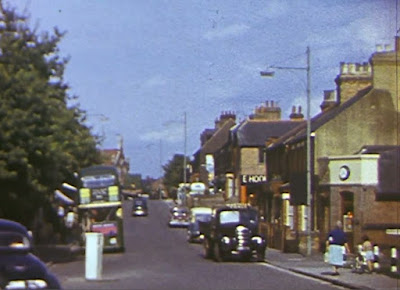Last month a photo appeared here of the former Sutton Road railway bridge. It had come from an 8mm film shot in 1954, believed to have been taken by a resident of Cambridge Road. The film is available to be viewed at the BFI Player website (search "St Albans").
The opportunity should not be lost in identifying other scenes from that film. For those who remember the scenes as they were the experience will be pure nostalgia. If you are younger, you will certainly identify the locations.
We begin with a screen grab from Wellington Road, taken from the junction with Cambridge Road. The film followed these three children on their bikes for some distance along a largely car-free road, and now they have paused near the camera to chat, and maybe decide what they might do next. They all appear to feel quite safe. The children probably lived in the road. Today they would be about 68 to 70 years old, and today it would not be possible to take such a photograph of an empty roadway.
The comprehensive play park at Clarence Park today is generously provided with equipment. But many of us recall the swings, the bucking horse, and that spinning roundabout which could be made to travel in either direction as fast as a child or teen could push it. Hold on very tight!
The far eastern end of Camp Road led to the entrance of Hill End Hospital. There is a small roundabout there today; the Lodge is still identifiable, though, somehow not as imposing today with its plainer windows. The entrance gates to the left of it have gone, and with them the former hospital buildings behind. Was it actually possible for a Green Line bus to stop right on the corner, as the stop flag seems to indicate on the left of the picture?
There are a few roads which rarely get a mention; one of them is Springfield Road. Don't know there it is? Look for it at the junction of Camp Road and Cell Barnes Lane. It is T-shaped, and this nice shot discovers one of the Ts.
It is not surprising that the man is pushing his bicycle, for this is Camp Hill. The building in the background, at the foot of the hill, is the former Campfield Press (Salvation Army Printing Works). The grass beside the hill would later be occupied by the Herts Advertiser and, more recently, Centurion House.
Double deck buses under London Transport ownership were still the norm, and this full vehicle on the 341 route to Hatfield shows an advertisement for Martell's as it turns from Stanhope Road into Hatfield Road.
The same bus pauses at the stop opposite to Martell's coal office (the former coachman's house for the Crown Hotel) – a nice connection with the photo above. Further along the road was the shop of E Hooker, a well-known glass trader and maker of stained glass windows. The old sodium street lamps are still in situ; they had caused such a rumpus among a number of women in 1938 because of the yellow lights' effect on the way their faces looked after dark.
Later in the year I'll post a few more screen shots from this lovely home movie.










